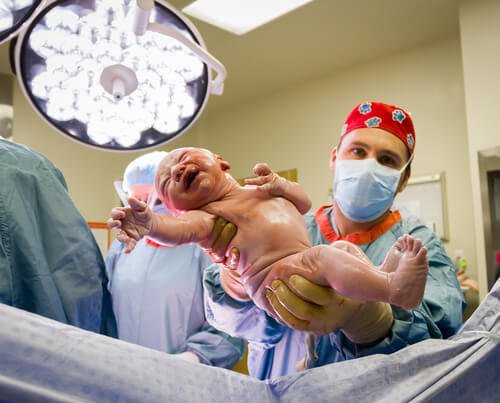The Walking Reflex in Babies

The walking reflex is an instinctive behavior that occurs in babies during their first month of life. Like many others, it’s an indicator of the healthy development of newborns. Let’s see what it consists of and what its warning signs are.
The appearance of reflexes is the most effective way that pediatricians have to assess whether babies are developing according to expectations. The most common is the Landau reflex, the gripping reflex, the Moor and the sucking reflex.
To this list, we could add the walking reflex, which appears approximately on the fourth day of life.
It’s really an eye-catching action for such a small being: so much so that recently a video that showed a newborn “walking” became viral.
According to normal parameters, the walking reflex should disappear when the baby reaches his first month of life. If it extends further, it could be considered as a warning signal, as we’ll see later.
How to assess the walking reflex?
The way to examine it is very simple: you must hold the baby by his armpits and place him upright as if he were standing. His response should be to extend and flex his feet and move them alternately as if he were trying to walk.
Also known as the “stepping reflex” or “primitive reflex“, this reflex usually reappears voluntarily later, between the eighth and twelfth month of life. By this time, the baby is getting ready to start walking.
When to worry?
The loss of reflexes isn’t a cause for concern if it occurs in due time. Given that the baby is learning, little by little, to manage his actions, it’s perfectly natural to stop reacting instinctively to each external stimulus.

In fact, what should cause alarm is the permanence of reflexes that should have disappeared. This could indicate a delay or deterioration in the baby’s motor development.
In these cases, the professionals proceed to examine the baby in greater depth to determine which steps to follow.
The loss of reflexes with the passage of time is perfectly natural, given that the baby is learning, little by little, to govern his actions and to stop reacting instinctively to each external stimulus.
Other reflexes characteristic of the first months
Along with the walking reflex, other so-called primary or archaic reflexes appear during the first weeks of life, including:
- Sucking reflex. This is the one that allows babies to drink from their mother’s breast to feed themselves, but it also occurs when other objects are brought to their lips.
- Rooting reflex. Babies should try to reach towards our finger when we touch close to their mouth. It also allows them to find their mother’s breast for breastfeeding.
- Prehension reflex. When we bring something close to their hand, they will try to hold it by closing it. It can also occur on the feet.
- Moro reflex. This is a defensive response in babies. In these cases, they cross their arms and then place them on their chest.
- Crossed-arm reflex (Moro). When babies hear a loud blow or experience an unexpected change of position, they suddenly separate the arms and then put them on their chest. This disappears after 6 months.
- Babinski reflex. Babies open their fingers in a fan shape when they rub the sole of their feet with an object.
- Asymmetrical tonic neck reflex. Indicates body coordination. When the babies’ head is kept to one side, the arm and the leg on that side remain extended. If they rotate their head, it bends.

In addition, babies also develop reflexes that will remain throughout their life. These include yawning, blinking, sneezing, coughing and deglutition.
Because of all of the above, it’s extremely important to comply with all the checkups and tests indicated during the first months of your baby’s life.
The pediatrician is in charge, even minutes after the delivery, of corroborating that all the child’s functions work perfectly. Keeping controls up to date will allow you to be sure that everything is going well with your baby’s development.
The walking reflex is an instinctive behavior that occurs in babies during their first month of life. Like many others, it’s an indicator of the healthy development of newborns. Let’s see what it consists of and what its warning signs are.
The appearance of reflexes is the most effective way that pediatricians have to assess whether babies are developing according to expectations. The most common is the Landau reflex, the gripping reflex, the Moor and the sucking reflex.
To this list, we could add the walking reflex, which appears approximately on the fourth day of life.
It’s really an eye-catching action for such a small being: so much so that recently a video that showed a newborn “walking” became viral.
According to normal parameters, the walking reflex should disappear when the baby reaches his first month of life. If it extends further, it could be considered as a warning signal, as we’ll see later.
How to assess the walking reflex?
The way to examine it is very simple: you must hold the baby by his armpits and place him upright as if he were standing. His response should be to extend and flex his feet and move them alternately as if he were trying to walk.
Also known as the “stepping reflex” or “primitive reflex“, this reflex usually reappears voluntarily later, between the eighth and twelfth month of life. By this time, the baby is getting ready to start walking.
When to worry?
The loss of reflexes isn’t a cause for concern if it occurs in due time. Given that the baby is learning, little by little, to manage his actions, it’s perfectly natural to stop reacting instinctively to each external stimulus.

In fact, what should cause alarm is the permanence of reflexes that should have disappeared. This could indicate a delay or deterioration in the baby’s motor development.
In these cases, the professionals proceed to examine the baby in greater depth to determine which steps to follow.
The loss of reflexes with the passage of time is perfectly natural, given that the baby is learning, little by little, to govern his actions and to stop reacting instinctively to each external stimulus.
Other reflexes characteristic of the first months
Along with the walking reflex, other so-called primary or archaic reflexes appear during the first weeks of life, including:
- Sucking reflex. This is the one that allows babies to drink from their mother’s breast to feed themselves, but it also occurs when other objects are brought to their lips.
- Rooting reflex. Babies should try to reach towards our finger when we touch close to their mouth. It also allows them to find their mother’s breast for breastfeeding.
- Prehension reflex. When we bring something close to their hand, they will try to hold it by closing it. It can also occur on the feet.
- Moro reflex. This is a defensive response in babies. In these cases, they cross their arms and then place them on their chest.
- Crossed-arm reflex (Moro). When babies hear a loud blow or experience an unexpected change of position, they suddenly separate the arms and then put them on their chest. This disappears after 6 months.
- Babinski reflex. Babies open their fingers in a fan shape when they rub the sole of their feet with an object.
- Asymmetrical tonic neck reflex. Indicates body coordination. When the babies’ head is kept to one side, the arm and the leg on that side remain extended. If they rotate their head, it bends.

In addition, babies also develop reflexes that will remain throughout their life. These include yawning, blinking, sneezing, coughing and deglutition.
Because of all of the above, it’s extremely important to comply with all the checkups and tests indicated during the first months of your baby’s life.
The pediatrician is in charge, even minutes after the delivery, of corroborating that all the child’s functions work perfectly. Keeping controls up to date will allow you to be sure that everything is going well with your baby’s development.
This text is provided for informational purposes only and does not replace consultation with a professional. If in doubt, consult your specialist.








